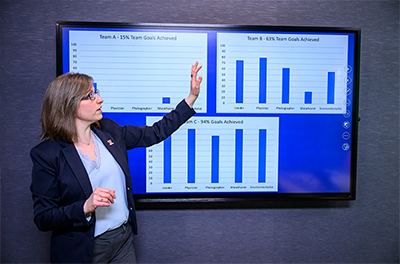
Nov 4, 2024 Accountancy Alumni Business Administration Faculty Finance Student
Shattering the mold of business education: The stackable credentials revolution
Recognizing the need for a more dynamic and accessible approach to business education, Gies College of Business is shattering the mold by offering stackable credentials that empower learners to build their skillset progressively, at their own pace.
“Education is no longer a linear path,” said former Dean Jeffrey Brown, one of the driving forces behind Gies Business’ ecosystem of degrees, badges, and certificates. “The one-size-fits-all business degree is outdated and unsustainable.”
Brown made stackable credentials a cornerstone of his nine years leading one of the top business schools in the country. Early in his tenure as dean, he saw the need to innovate.
“The pace of technological change creates a need for true lifelong learning,” said Brown. “Business schools must adapt. Degrees will not go away, but those that experiment with new models and offerings will thrive in the future.”
Disruption at the doorstep
Like any established industry or profession, business schools are subject to disruptive forces on a global scale.

Those who graduated from leading institutions just a few years ago already face a harsh reality: The breakneck pace of technology demands continuous learning. Fields such as data analytics, AI, machine learning, augmented reality, blockchain, and quantum computing are rapidly transforming jobs, organizations, and entire industries. The pandemic accelerated the shift, forcing swift change in teaching methods, recruiting, and employment practices.
To thrive in this evolving business environment, learners around the globe are demanding a complete educational suite that delivers new skills as they need them, with a clear return on investment. They value accessible, flexible, high-quality offerings that don’t require leaving the workforce to attend on-campus programs.
“I have an engineering background and hold a senior leadership role in my organization, but to be most effective, I needed to address the gaps in my knowledge of accounting and finance,” said George Kuruvilla, a technology executive with more than two decades of experience, who earned his MBA from Gies Business in 2023. “The Gies MBA program is progressive, changes with the times, and offers specializations that are relevant. I was able to immediately apply what I learned. It changed how I think and greatly benefited my leadership skills.”
The Gies Business model: Flexible and personalized
The Gies Business model for continuous learning recognizes that viewing education and work as separate, sequential activities is no longer practical.
“We meet learners wherever they are,” said Brooke Elliott, dean at Gies. “We make it easy and economical for them to jump in and out of their educational journey throughout their careers. By combining online education with a wide array of credentials, they can upskill or reskill as needed, applying what they’ve learned to the workplace immediately.”

Gies Business began building this foundation in 2016 when it launched a fully online MBA at a market- shattering price of less than $22K. Three years later, the College suspended its on-campus MBA programs to refocus resources into the online offering. That move proved prescient with the iMBA now reaching more than 100 countries and attracting 4,000 current learners, who typically work full-time and avoid the massive debt often associated with traditional MBAs.
The successful formula has served as the template for Gies’ full suite of offerings. Today, the College offers an online undergraduate business minor, 10 on-campus and online master’s degrees and 14 certificates– with more on the way.
Learners can start with a non-credit or for-credit course, and then apply those learnings toward a transcriptable graduate certificate. Or they can start with a certificate and stack it into a degree. Offerings include stackable for-credit and non-credit courses in topics ranging from business strategy to managing organizations to central banks and monetary policy.
The Gies approach allows learners to test the waters before fully jumping into a degree program. A reduced requirement for prerequisites allows these learners to take stand-alone classes in almost any order so they can build a learning experience that best fits their personal life and professional needs.
“No effort a student makes is wasted – from a single course to a degree, every component complements the others without duplication,” said Elliott.
Meeting market demand: The rise of the self-made degree?
Elliott and Brown believe universities clinging to traditional models may contribute to the rise of third- party credentials to meet this market demand. Brown imagines a future where learners can create their own “degree.”
“Imagine a self-made MBA on a resume, comprised of recognized credentials from a half dozen top institutions,” said Brown. “It is not difficult to foresee a time when a third-party business emerges that certifies someone has earned the equivalent of a degree.
“But if universities continue to have the mentality of ‘if we did not teach it ourselves, the students cannot possibly have learned it’ they will miss out on meeting a clear, powerful market demand,” said Brown.
Challenges and investments
Making the transition to a more accessible
and affordable portfolio of learning experiences isn’t
without its challenges.
“In building these programs, we’ve had to navigate how to deliver a high-quality learning experience for a global audience ranging from 18 to 88 years old,” said Elliott. “Our structure and resources are designed for maximize flexibility and growth.”
Quality content & engagement
Gies prioritizes offering the same quality
teaching and support as it does for its traditional
on-campus degrees. For-credit and non-credit learning
opportunities are regularly created by full-time tenured
professors, industry experts, and even a former dean
of the College. Self-paced content is complemented
by high-engagement components such as weekly live
sessions with faculty, graded assignments, group work, discussion boards, and faculty office hours.
Investment in infrastructure & resources
Gies has strategically reinvested revenue generated
from its stackable offerings into resources and
infrastructure. The number of faculty has grown by more
than 40 percent in just six years, fueling both research
output and the College’s ability to develop innovative
programs. With the support of alumni, Gies is also
committed to giving teachers and students a superior
learning experience. The next phase is underway with
the construction of Steven S. Wymer Hall, a state-of-
the-art building that in 2025 will house new content
creation studios, classrooms, and collaborative spaces.
More than 60 people support Gies’ Teaching & Learning efforts: This includes video producers, live session directors, instructional designers, graphic artists, and much more. Together, they deliver more than 100 online courses and 40-plus live sessions each week.
Institutional changes for accessibility
This shift has required more collaboration, time, resources, and flexibility. Units worked together to make institutional changes that align with Gies’ innovative model. For example, Gies offers five annual intakes of new learners compared to the traditional one or two and operates on a pay-as-you-go model, which differs greatly from the standard tuition model.
To increase accessibility to its degrees, Gies has de-emphasized GMAT testing because its acceptance criteria create biases in the applicant pool and perpetuate a lack of student diversity.
“Collectively, we are in a unique position to challenge the traditions that increasingly stand in the way of innovation,” said Brown. “Business school leaders must embrace change and intentionally guide business education toward programs built on academic rigor and relevance.”
